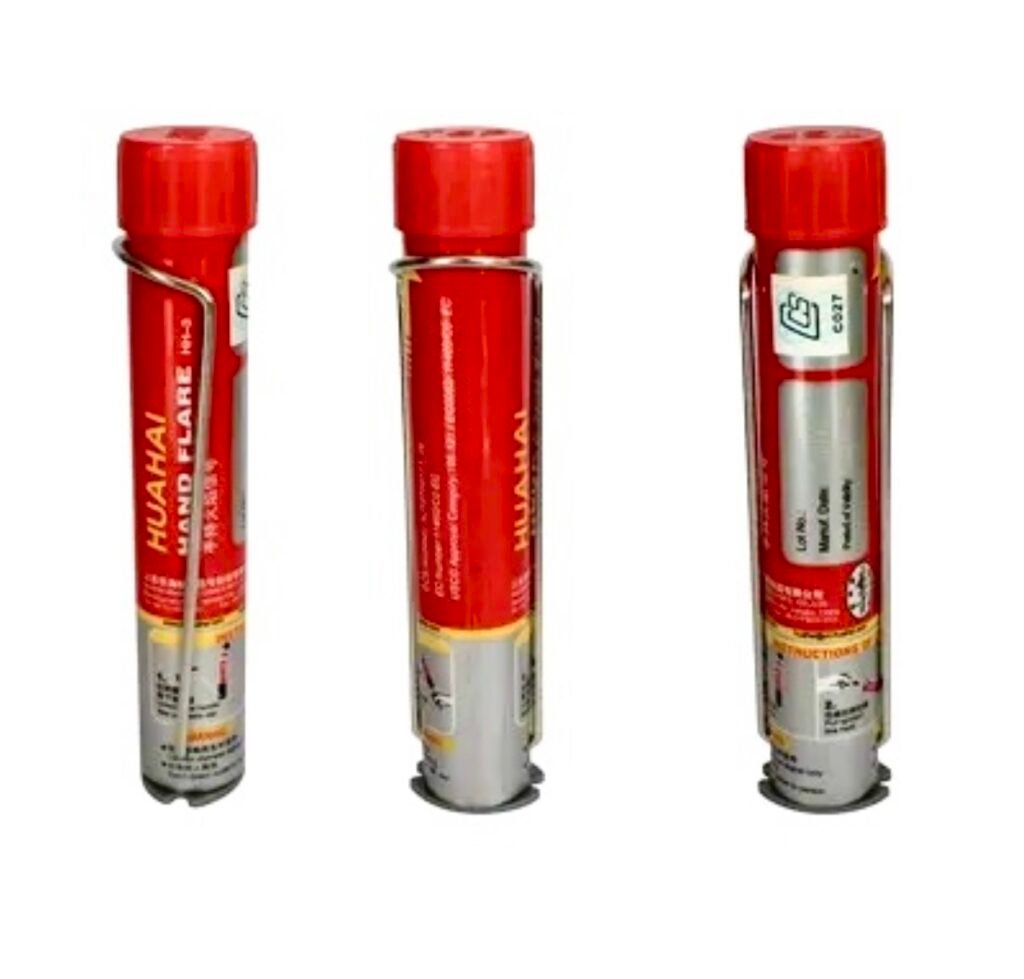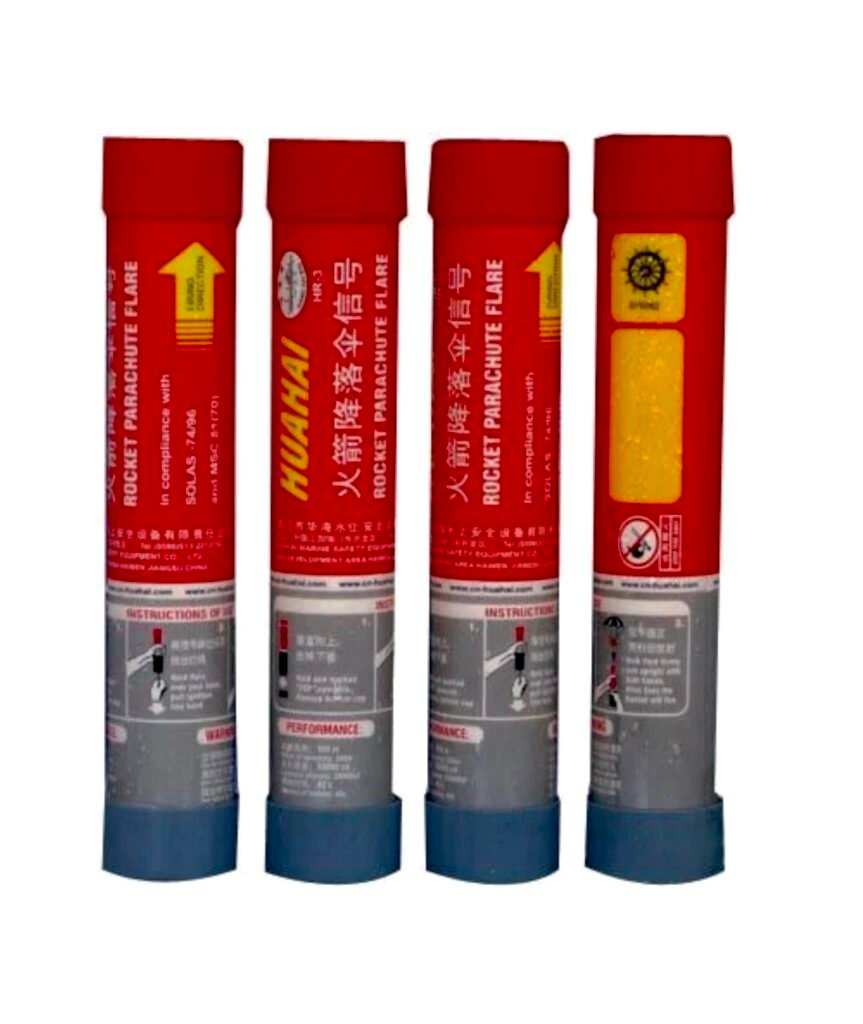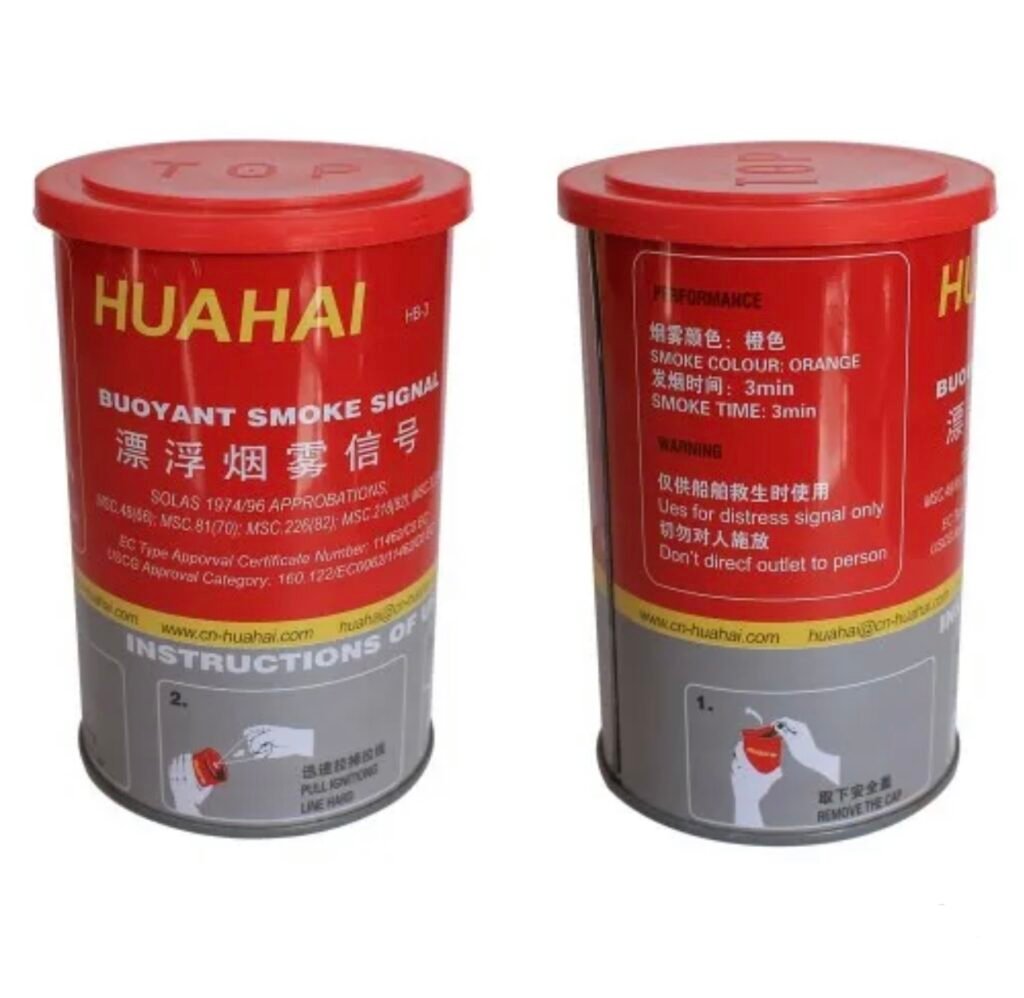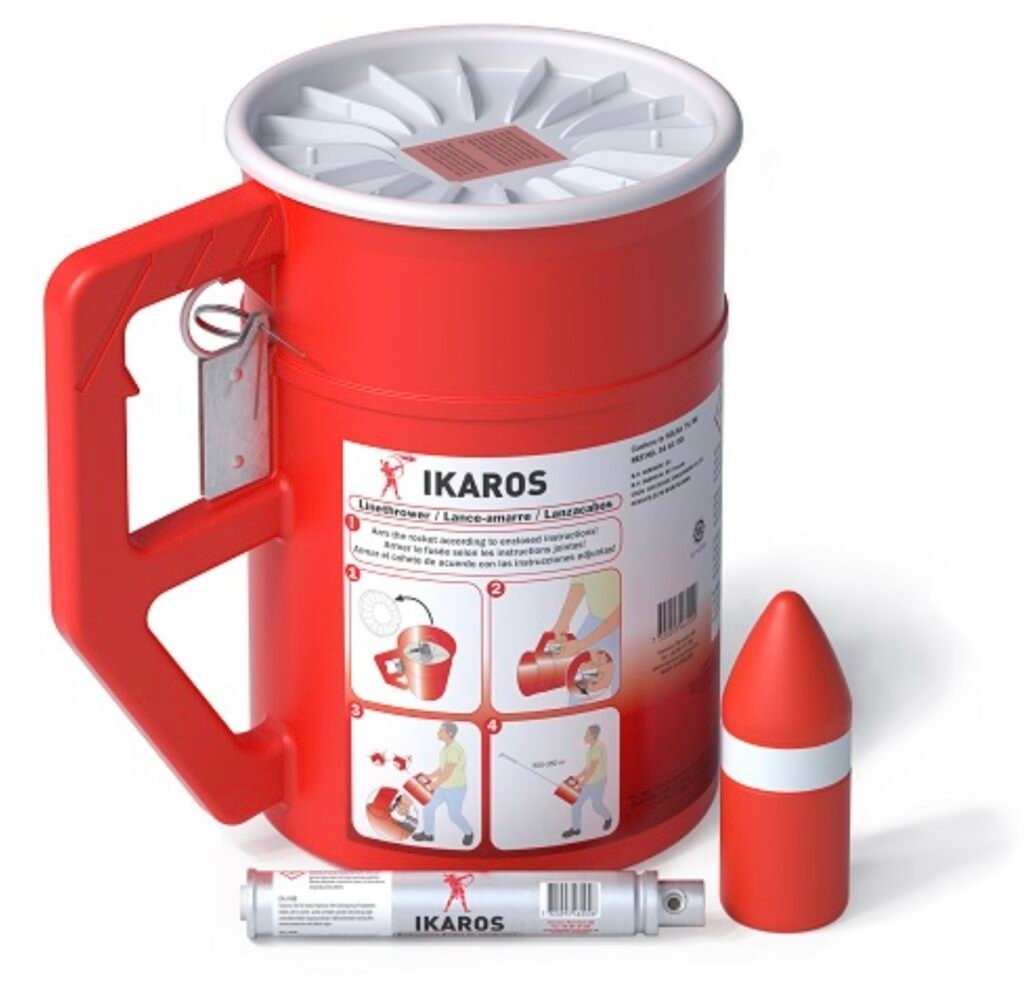Pyrotechnics is the science of using materials capable of undergoing self-contained and self-sustained exothermic chemical reactions for the production of heat, light, gas, smoke and/or sound.
Used under extreme emergency situations (such as distress), these are provided onboard ships to grab the attention/inform ships within range so as to seek help and assistance of the vessels for rescue. Basically, it is a visual method of sending SOS signals. These pyrotechnics are used in time of distress is mentioned in Annex 4 of COLREGs.
In the unfortunate event (such as an ‘abandon ship’ situation) wherein one’s own ship is beyond saving, pyrotechnics can be one of the last resorts for the ship personnel’s survival and rescue out at sea. Pictorial representation for usage at sea is displayed on the cover of each of the units mentioned below.
In simple words:
Pyrotechnics are the distress flares used at the time of abandoning the ship or used in survival crafts which produces visual signals (light or smoke signals) to attract attention of the other crafts at sea.
PyroTechnics Requirement as per Requirement according to location:
1. Bridge
- Hand Flares (06 nos)
- Rocket Parachute Flares (12 nos)
- Buoyant smoke signal (02 nos; 01 on each side, port, and starboard)
- Line throwing appliance (at least 01 no)
2. Lifeboat
- Hand Flares (06 nos)
- Rocket Parachute Flares (04 nos)
- Buoyant smoke signal (02 nos)
Requirements Regarding PyroTechnics Put Forth by SOLAS
Having pyrotechnic equipments on board ship is not enough. They should be in proper ship-shape, handy, easy to use, and effective when any kind of emergency take place on ship. For this reason, SOLAS has but forth rules and regulations regarding storing, handling, and working of pyrotechnic equipments use on board ships.
Different Types PyroTechnics Available Onboard Ships and their requirement as per SOLAS

Hand flare

A hand flare is a small cylindrical stick which when activated, produces an intense red smoke or light without an explosion. Should be held out leeward when activated. Can be used by the day as well as night.
What are the requirements of hand flare as per SOLAS?
Hand Flare. (6 pieces per life boat & life raft for F.G vessel, for short voyage 3 pieces.)
According to Chapter III Visual Signals, 3.2 Hand Flares of the LSA Code
The hand flare shall:
- be contained in a water-resistant casing;
- have brief instructions or diagrams clearly illustrating the use of the hand flare printed on its casing;
- have a self-contained means of ignition;
- be so designed as not to cause discomfort to the person holding the casing and not endanger the survival craft by burning or glowing residues when used in accordance with the manufacturer’s operating instructions.
- burn with a bright RED colour, 5-8 Nautical mile of visibility.
- burn uniformly with an average luminous intensity of not less than 15,000 cd;
- have a burning period of not less than 1 min;
- continue to burn after having been immersed for a period of 10s under 100 mm of water.
Rocket parachute flare

Rocket parachute flares are designed to fire a projectile high in the air, then burn a bright red light while parachuting back down to the sea. They have the longest potential visual range out of all these pyrotechnic distress signals. They are meant to be used first, with the intention of attracting help from a long way off. Some rocket parachute flares claim a visibility of 30 miles, although that will vary with local conditions.
The minimum requirements for rocket parachute flare as per SOLAS chapter III regulation 26 includes all the points mentioned above with following more requirements:
- The minimum vertical height of rocket, when fired from the operating point, must be 300 m.
- A parachute must be activated when it reaches top or near to the top of it’s trajectory level
- It must burn for a period not less then 40 sec with minimum luminous intensity of 30000 candelas.
- The rate of decent after opening of the parachute must be minimum 5 m/sec.
- Arrangement must be such that it must not damage or burn the parachute when the flare is activated.
Buoyant smoke signals

Smoke signals are different to the other two types of flares in that they do not give off a bright light. This means that they are not especially useful at night. At night they are only useful in so much as they give off some heat which could be picked up by a rescuer with thermal imaging.
They are mainly useful when rescuers are close by, to pinpoint your actual position.
Wind is a factor with these signals. If there is no wind, the signal will rise high up into the sky and be effective at longer range. The opposite of course applies if it is a windy day.
Smoke is particularly useful if a helicopter is searching for you because it will provide them with an indication of wind speed and direction at your location.
The minimum SOLAS requirements for buoyant smoke signal as per regulation 37 are:
- Contained in water resistance buoyant container with clear diagram for operating instruction.
- It should not ignite or explode if used as per the described operating instruction.
- Smoke emitted must be of high visible color with a uniform rate and minimum period of 3 min.
- It must emit only smoke and not flame when floating in calm water.
- If immersed in water, it must emit smoke for a period of minimum 10 sec.
While it only requires a highly visible colour, usually the smoke is orange. Orange smoke is the recognised distress colour of smoke from the International Regulations for Preventing Collisions at Sea.
Line Throwing Apparatus

The minimum requirements for this appliance as per regulation 49 are:
- Must have good accuracy.
- A brief instruction with diagram must be present in the container.
- Must have minimum 4 projectiles, each carrying line to at least 230 m in calm water.
- Must have 4 lines with breaking strength not less then 2 kilo Newton.
Advantages and Disadvantages of Pyrotechnic Flares
Unless you are legally obligated to carry flares in your country, the decision will inevitably come down to your own assessment of the advantages and disadvantages.
Advantages
• They are recognised distress signals. Any other navigator seeing them will know that you are in distress.
• They work independently of all electronic equipment. Not only are they independent of the power supply on your own vessel, they also don’t need their own battery. You never need to worry about the battery being flat.
• Nothing is better than bright orange smoke to indicate your position during the daytime. Not only does show up clearly, it helps rescuers by showing the wind.
• They will reassure your crew. Seeing bright lights and billowing smoke can help boost morale in an emergency situation.
Disadvantages
- Pyrotechnics need replacing when they reach their expiry date. This is an additional cost, both financial and in time.
- The “danger” of having explosives on board.
- You do not know if your signal has been seen. If someone has seen your signal and taken action, you will probably be unaware until you actually see assistance coming.
- They only work if someone else is close enough to see you. Close to a busy coastline, or in a high traffic area, pyrotechnic flares will be very effective. On a remote stretch of coastline, there may well not be anyone close enough to see.
- You may have an emergency and still have no use for pyrotechnics. VHF, EPIRBS, SARTS and Satellite communication are far more effective in most situations.
LED Flares
Over the last few years, LED Flares have started to gain popularity. The idea is to replace the bright light that is produced by burning pyrotechnics with a bright light from a safe LED source.
They act in exactly the same way as pyrotechnic flares. They pinpoint your location to rescuers once they are already close to your position.
LED Flares can always be considered as additional safety equipment, but they are not yet as effective as pyrotechnic flares.
Limitations of LED Flares
The biggest issue with LED flares is that they are not actually a recognised distress signal.
At the beginning of this article we briefly discussed the International Regulations For Preventing Collisions At Sea and the definition of a distress signal. According to the IRPCS, LED flares are still not recognised as a distress signal.
If you are out at sea, and you use an LED flare, there is no guarantee that the lookout on a ship would realise that you are in distress.
Countries are starting to work together to establish a uniform set of standards for LED flares in the hope that they will be recognised internationally in the future. For now though, they remain an un-official way of indicating distress.
